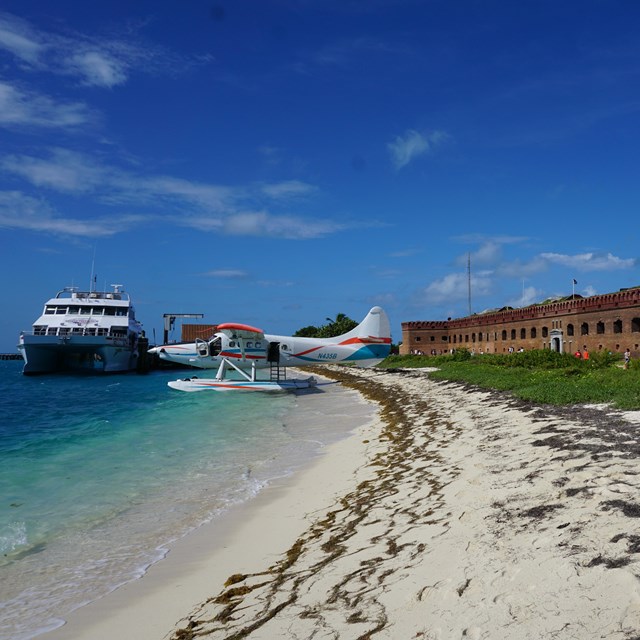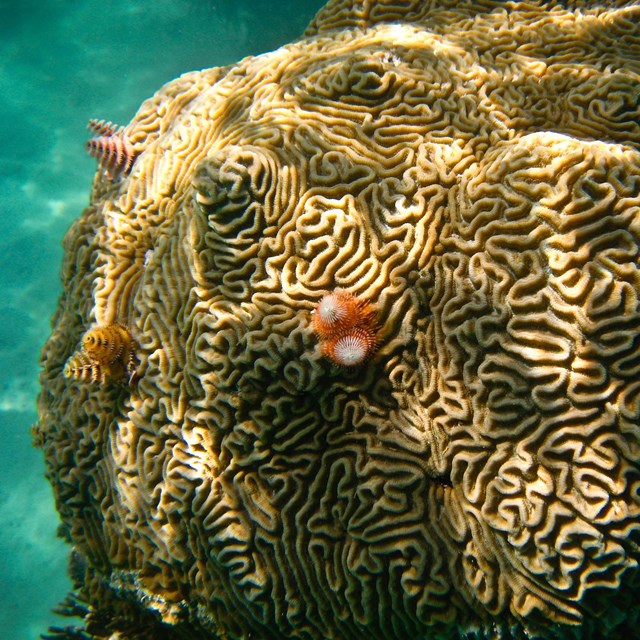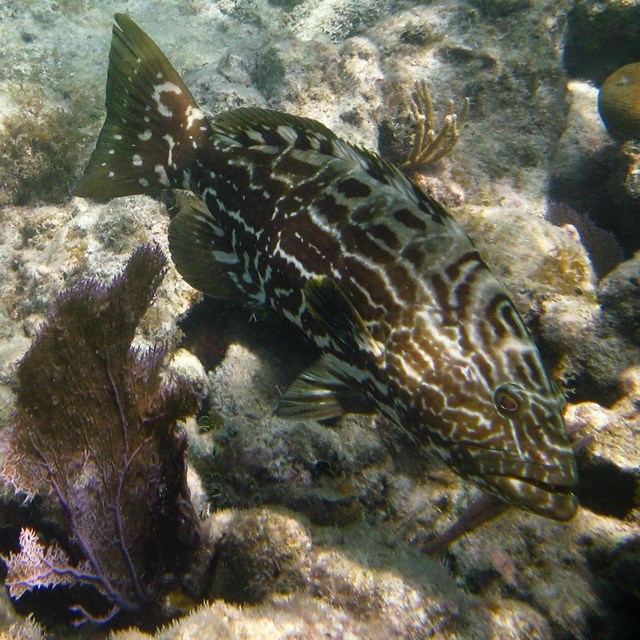
NPS Photo Explore Dry Tortugas UnderwaterWith less than 1% of Dry Tortugas National Park being dry ground, the best way to see this remarkable national treasure is by getting in the water. Dry Tortugas National Park is situated at the southwest corner of the Florida Keys reef system, the third largest in the world. Due to the remote location, and easterly flowing gulf current just south of the park, you are sure to discover a much greater abundance of marine life and often much larger versions than anywhere else in the Florida Keys. Remember: Look, but don't touch!All coral, reef fish, and cultural artifacts are protected. You should not fear an attack from the marine wildlife, but you need to keep a lookout to make sure YOU don't bump into them. Not only will an accidental brush up against the coral probably kill it, you may be bumping into any number of potentially dangerous animals, include fire coral, jellyfish, sea urchins, or the exotic venomous lionfish.
Snorkel & Dive AreasVisitors arriving to Garden Key by way of the commercial ferry or seaplane will be able to explore a variety of unique underwater habitats and cultural artifacts. Closure: Sections of moat wall closed to snorkelingFrom April to June 2023, approximately one-half of the moat wall will be closed to snorkeling during coral relocation work. Signs will be posted and closed areas will be marked with swim lanes. Beaches and moat walkway remain open. 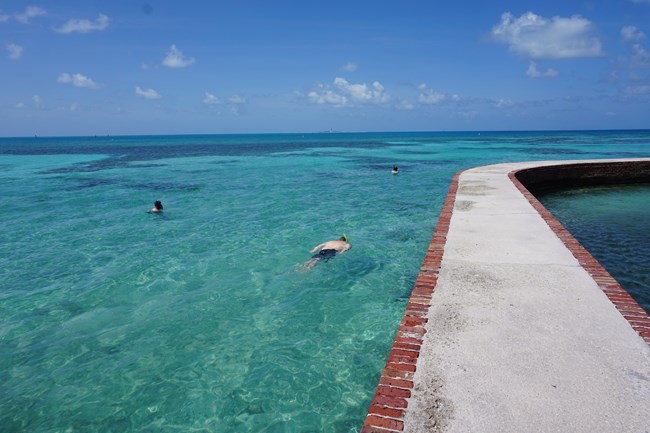
Garden Key & Nearby SitesIn order to protect Fort Jefferson from an amphibious assault, and to add protection from the rough waters of the Gulf of America, a wall was built around the fort creating a moat in between the fort and the moat wall. In the late 1800s the US Navy built coaling warehouses and piers to refuel their ships. Eventually a particularly strong hurricane saw to the destruction of these structures and the Navy decided not to rebuild them. This is a rare treat. Outside the moat wall of Fort Jefferson an eerie sense of history meshes with the natural wonders of the underwater world. It is safe enough for kids who are comfortable in the water and exciting enough to stimulate the kid in the most jaded adult.
The fish are much more docile at night and can be approached much closer than during the day. Be careful not to shine your light directly at the fish as this both startles them and temporarily blinds them. They will then dart off and run straight into a coral head or the moat wall. Remember we are only visitors here and should respect those that make this place their home. Other things you are apt to see include lobsters, decorator crabs, arrowhead crabs, coral shrimp, and squid. Daytime diving is for the underwater vistas; night diving is a more intimate experience. Your world has shrunk and you need to bring your focus into a smaller field of vision. In that reduced field, you will begin to see much more detail. This area is almost due north of Garden Key in about 55 feet of water. It consists of a huge mound of coral that emerges from the sand at about 55-60 feet of water and rises toward the surface to a depth of about 35 feet. The reef is rather isolated and is surrounded by sand. It takes a full dive to swim around the mound. As you slide over the side of your boat, you may be immersed in a cloud of fish that are stacked up from the top of the reef almost to the surface. At first glance, they seem to be a fluid extension of the coral. Because the mound protrudes from a much lower reef, it is a magnet for marine life. On the north side of the reef is a forest of deep water sea fans that will rival anything to be found in the Caribbean. If you carefully investigate some of the nooks and crevices in this area of the reef, you will find some rare black coral. For the underwater shutterbug, this is a great place to photograph corals. With the exception of elkhorn and staghorn, almost every species of stony coral can be found here. In fact, this area is used as a coral growth monitoring station for ongoing research. If you happen on some obviously manmade apparatus while exploring this reef, it is probably part of this program. Please do not disturb any, of these sites as you could be harming some valuable environmental research. 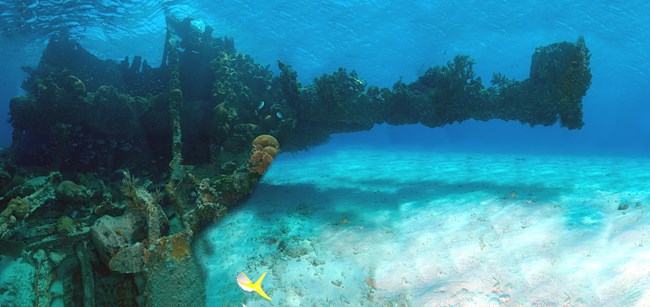
Loggerhead Key SitesALERT: The Windjammer dive site mooring ball (SW of Loggerhead Key) has been damaged and is off-station. Please call "National Park Service, Dry Tortugas" on vhf16 when within the national park for latest information on availability of this dive site. The most popular dive in the park is the wreck known as the Windjammer. Its real name was Avanti. Built in 1875, the three-masted, iron-hulled, sailing ship wrecked on Loggerhead Reef in 1901 on its way to Montevideo with a cargo of lumber. Before diving this site, be sure to pick up a laminated underwater map at the visitor center. This map will provide you with a self-guided tour of the wreck and allow you to make sense of what you are seeing. Depths on this site range from zero feet, where a small piece of wreckage actually breaks the surface, to 20 feet. Located off the north side of Loggerhead Key, this area is protected, shallow, and calm-a great place for snorkelers, and under most conditions, for children. Juvenile barracuda, lobsters, corals heads, soft corals, and tropical fish are usually visible.
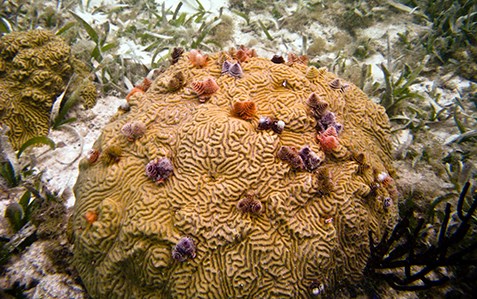
Eastern Park Boundary SitesSnorkel site
This area marks the eastern boundary of the park. A navigational light tower marks the shoals themselves. Here the reef consists of scattered very shallow coral heads. In the days before navigational aids and accurate charts, these shoals claimed many ships and as a result, the diver can find the scattered remains of a wide variety of shipwrecks. When diving these sites, please remember to leave all the artifacts where you find them. This courtesy will allow other divers who come after you to enjoy the same sense of discovery. It is also against the law to remove any cultural artifacts and this particular law carries some serious penalties for divers who ignore it. For more adventuresome diving, go just beyond the boundary buoys in about 75 to 80 feet of water and follow this depth curve looking for changes in reef elevation. It should not take long to find open ocean critters that will make for some exciting diving. Be very careful of the currents out here, as they are strong and variable in direction. As you descend into the deep blue water, you can expect to see very large grouper, and abundance of snapper, and often sharks. Black tips, hammerheads, bull, and nurse sharks are all common sights out here. In addition, you may also get to see turtles and some large formations of eagle rays. The diving out here is not for the timid or the novice diver. Be sure you know what you are getting into before you take the plunge. If you get yourself into trouble out here, you are a long way from help. Helpful Snorkel & Dive Resources
|
Last updated: February 24, 2025

